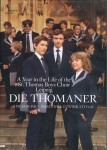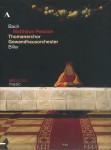
 Die Thomaner - A Year in the Life of the St. Thomas Boys Choir, Leipzig
Die Thomaner - A Year in the Life of the St. Thomas Boys Choir, Leipzig
Paul Smaczny; Gunter Atteln
Accentus Music ACC 20212
Bach - Matthaus Passion
Thomanerchor; Gewandhausorchester; Georg Christoph Biller
Accentus Music ACC 20256
The Leipzig Thomanerchor was founded in 1212 and the Thomasschule, of which the choir became part, followed soon after. The DVDs under review were issued on the occasion of the 800th anniversary of the choir. Johann Sebastian Bach was the Cantor there from 1723 until his death in 1750. It was for Leipzig that he wrote most of his cantatas as well as the two great Passions: St. John and St. Matthew.
Although now the choir is the jewel in the crown for both the school and the city of Leipzig, that was hardly true in Bach’s time. Bach was responsible for the music not in just one church but in five. He was to complain that pupils were generally admitted on academic, not musical grounds. At one point he calculated that among the pupils 17 were “usable,” 20 might become “usable” at some point and 17 were unmusical. Bach also had to find orchestral musicians. They had to be paid but the city administration refused to fund more than eight. Many of the schoolboys played instruments but, if they were used as instrumentalists, that further reduced the number of singers available. We should also remember that in Bach’s time a boy’s voice did not change until much later than is the case now. He would not become a tenor or bass until 17 or 18. The advantage of this would have been that trebles would be more mature and experienced than they are now, but it would produce difficulties with the lower voices.
The documentary presents a year in the life of the school; it also shows the trajectory from the initial auditions for five-year-olds to the tearful farewells of those who at 18 have to leave the choir after having spent much of their young lives there. We see the choir in rehearsal, in performance and on a tour to South America; we also see them playing soccer and having pillow fights.
Two recent recordings of the St. Matthew Passion perform the work one voice to a part; the Evangelist and the Christus are also the tenor and the bass of the first choir. By contrast, this performance could be called old-fashioned: it uses six adult soloists, a large (divided) boys choir, a (divided) modern orchestra, modern pitch and no viola da gamba. But if one judges it on its own terms, as one should, it is very successful; I found watching and listening to it a very moving experience. The soloists are all good but the finest is the Christus, the bass Klaus Mertens, who sings with wonderful sonority, impeccable diction and true involvement. At the end there is no applause. Quite right: who would want to applaud the Crucifixion?



